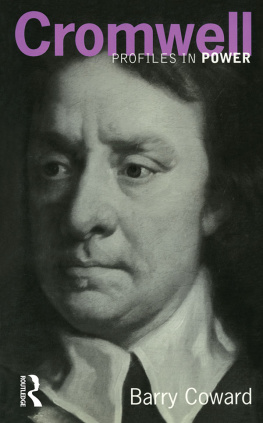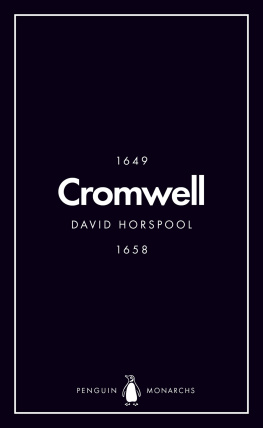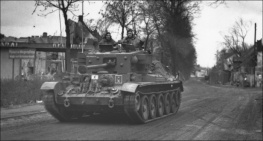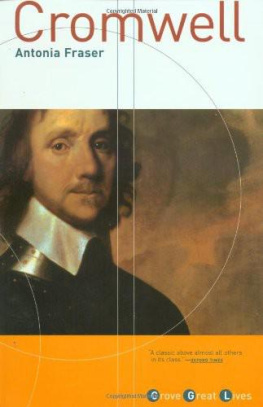| Note: | Images of the original pages are available through Internet Archive. See https://archive.org/details/gardinercrom00garduoft |
OLIVER CROMWELL
WORKS
BY
SAMUEL RAWSON GARDINER
HISTORY OF ENGLAND, from the Accession of James I. to the Outbreak of the Civil War, 16031642. 10 vols. crown 8vo, 5s. net each.
A HISTORY OF THE GREAT CIVIL WAR, 16421649. 4 vols. crown 8vo, 5s. net each.
A HISTORY OF THE COMMONWEALTH AND THE PROTECTORATE. 16491660. 4 vols. crown 8vo, 5s. net each.
A STUDENT'S HISTORY OF ENGLAND. From the Earliest Times to 1885.
Vol. I. B.C. 55 A.D. 1509. With 173 Illustrations. Crown 8vo, 4s.
Vol. II. 15091689. With 96 Illustrations. Crown 8vo, 4s.
Vol. III. 16891901. With 109 Illustrations. Crown 8vo, 4s.
* * * Complete in One Volume, with 378 Illustrations. Crown 8vo, 12s.
A SCHOOL ATLAS OF ENGLISH HISTORY. Edited by Samuel Rawson Gardiner , D.C.L., LL.D. With 66 Coloured Maps and 22 Plans of Battles and Sieges. Fcp. 4to, 5s.
CROMWELL'S PLACE IN HISTORY. Founded on Six Lectures delivered at Oxford. Crown 8vo, 3s. 6d.
OLIVER CROMWELL. With Frontispiece. Crown 8vo, 5s. net.
WHAT GUNPOWDER PLOT WAS: a Reply to Father Gerard. With 8 Illustrations and Plans. Crown 8vo, 5s.
THE FIRST TWO STUARTS AND THE PURITAN REVOLUTION, 16031660. 4 Maps. Fcp. 8vo, 2s. 6d.
THE THIRTY YEARS' WAR, 16181648. With a Map. Fcp. 8vo, 2s. 6d.
OUTLINE OF ENGLISH HISTORY, B.C. 55 A.D. 1901. With 67 Woodcuts and 17 Maps. Fcp. 8vo, 2s. 6d.
THE FRENCH REVOLUTION, 17891795. By Mrs. S. R. Gardiner . With 7 Maps. Fcp. 8vo, 2s. 6d.
LONGMANS, GREEN, AND CO.
39 PATERNOSTER ROW, LONDON
New York, Bombay, and Calcutta
Printed in Paris
Oliver Cromwell
From the Original Panel by Samuel Cooper
at Sidney Sussex College, Cambridge.
OLIVER CROMWELL
BY
SAMUEL RAWSON GARDINER, M.A.
HON. D.C.L. OXFORD: LITT.D. CAMBRIDGE: LL.D. EDINBURGH: PH.D. GTTINGEN
LATE FELLOW OF MERTON COLLEGE: HONORARY STUDENT OF CHRIST CHURCH
FELLOW OF KING'S COLLEGE, LONDON
WITH FRONTISPIECE
NEW IMPRESSION
LONGMANS, GREEN, AND CO.
39 PATERNOSTER ROW, LONDON
NEW YORK, BOMBAY, AND CALCUTTA
1909
OLIVER CROMWELL.
CHAPTER I.
KING AND PARLIAMENT.
Oliver Cromwell, the future Lord Protector of the Commonwealth of England, was born at Huntingdon on April 25, 1599, receiving his baptismal name from his uncle, Sir Oliver Cromwell of Hinchingbrooke, a mansion hard by the little town. It was at Huntingdon that the father of the infant, Robert Cromwell, had established himself, farming lands and perhaps also adding to his income by the profits of a brewhouse managed by his wife, Elizabetha descendant of a middle-class Norfolk family of Stewardoriginally Stywardwhich, whatever writers of authority may say, was not in any way connected with the Royal House of Scotland.
"I was," said Cromwell in one of his later speeches, "by birth a gentleman, living neither in any considerable height nor yet in obscurity. I have been called to several employments in the nation, andnot to be overtediousI did endeavour to discharge the duty of an honest man in those services to God and His people's interest, and to the Commonwealth." The open secret of Cromwell's public life is set forth in these words:his aim being: first, to be himself an honest man; secondly, to serve God and the people of God; and thirdly, to fulfil his duty to the Commonwealth. In this order, and in no other, did his obligations to his fellow-creatures present themselves to his eyes. For the work before him it could not be otherwise than helpful that his position in life brought him into contact with all classes of society.
What powers and capacities this infantor indeed any other infantmay have derived from this or the other ancestor, is a mystery too deep for human knowledge; but at least it may be noted that the descent of the Cromwells from Sir Richard Williams, the nephew of Thomas Cromwell, the despotic Minister of Henry VIII., brought into the family a Welsh strain which may have shown itself in the fervid idealism lighting up the stern practical sense of the warrior and statesman.
Of Oliver's father little is known; but his portrait testifies that he was a man of sober Puritanism, not much given to any form of spiritual enthusiasmvery unlike his elder brother, Sir Oliver, who had inherited not only the estate, but the splendid ways of his father, Sir Henry Cromwellthe Golden Knightand who, after running through his property, was compelled to sell his land and to retire into a more obscure position. As the little Oliver grew up, he had before his eyes the types of the future Cavalier and Roundhead in his own family. So far as parental influence could decide the question, there could be no doubt on which side the young Oliver would take his stand. His education was carried on in the free school of the town, under Dr. Beard, the author of The Theatre of God's Judgments Displayed, in which a belief in the constant intervention of Providence in the punishment of offenders was set forth by numerous examples of the calamities of the wicked. Though Oliver afterwards learned to modify the crudeness of this teaching, the doctrine that success or failure was an indication of Divine favour or disfavour never left him, and he was able, in the days of his greatness, to point unhesitatingly to the results of Naseby and Worcester as evidence that God Himself approved of the victorious cause.
In 1616 Cromwell matriculated at Sidney Sussex College, Cambridge, where his portrait now adorns the walls of the College hall. After a sojourn of no more than a year, he left the University, probablyas his father died in that yearto care for his widowed mother and his five sisters, he himself being now the only surviving son. It is said that not long afterwards he settled in London to study law, and though there is no adequate authority for this statement, it derives support from the fact that he found a wife in London, marrying in 1620, at the early age of twenty-one, Elizabeth Bourchier, the daughter of a City merchant. The silence of contemporaries shows that, in an age when many women took an active part in politics, she confined herself to the sphere of domestic influence. The one letter of hers that is preserved displays not merely her affectionate disposition, but also her helpfulness in reminding her great husband of the necessity of performing those little acts of courtesy which men engaged in large affairs are sometimes prone to neglect. She was undoubtedly a model of female perfection after the Periclean standard.








